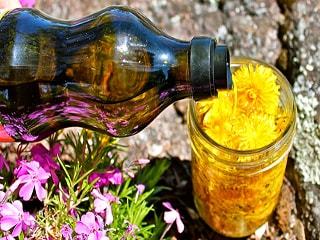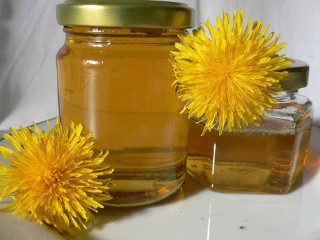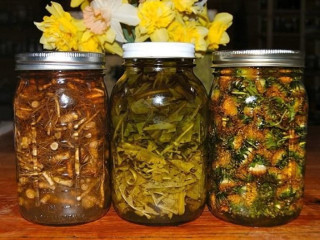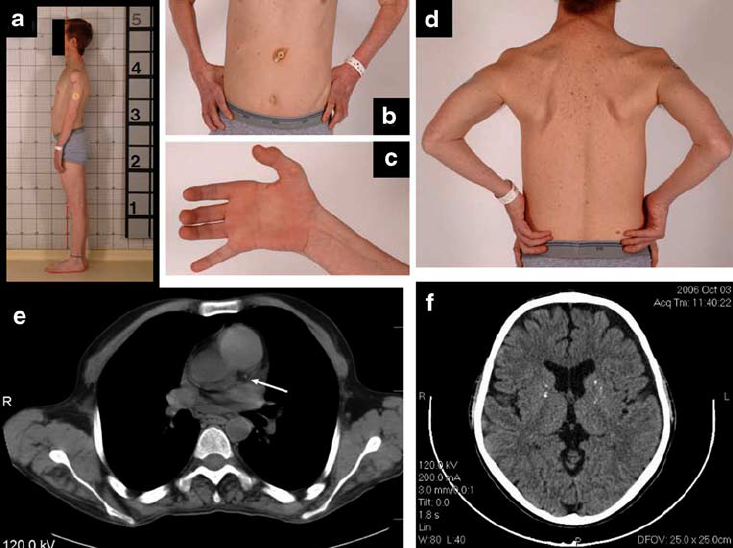Dandelion tincture: for joint pain and other conditions

Content:
- For joints
- In cosmetology
Dandelion, known no doubt to everyone, in addition to the favorite hobby of children in the form of weaving wreaths and making bouquets, is also used for medicinal purposes. Moreover, a description of the chemical composition and method of its use is given in many manuals on pharmacognosy.
Doctors are sure that decoctions and tincture of dandelion in vodka or plain water has a wide range of therapeutic activity and recommend it for the treatment of a variety of diseases, ranging from digestive problems to disorders of the musculoskeletal system apparatus.
So what do scientists say about a weed that blooms in bright yellow spots in early spring along roads, in meadows and clearings in the forest? Dandelion (Taraxacum officinale) is a perennial herb that can be up to 30 cm long.
The root is wide at the base (up to 2 cm in diameter) and tapering downward extends almost 60 cm deep into the soil. Dandelion leaves are smooth, narrow in shape and wavy edge, collected in a rosette at the base of the stem. A straw-yellow flower on a long fleshy hollow stem. Dandelion blooms from mid-spring to early summer, sometimes blooms in autumn, seeds appear in late May-July.
Distributed in the European part of Russia, Ukraine and Belarus. For medicinal purposes, the whole plant is used as a whole. The stems with inflorescences, leaves and juice should be harvested in June, and the root - at the end of September-October, but before the onset of frost. If you pluck the stem of a dandelion, white juice will come out, which contains a large amount of the glycoside taraxacin. The root of the plant is also rich in this healing compound.
This bitterness has an appetite-stimulating effect, improves the secretion of digestive enzymes and gastric juice, and stimulates intestinal motility. Therefore, dandelion tincture is indicated for gastritis, colitis, enteritis, hemorrhoids, which are accompanied by constipation, pain and cramps in the stomach and lack of appetite.
In addition, the following chemical compounds were found in the roots of the plant:
- inulin;
- sucrose;
- polysaccharides and other protein components;
- mucus;
- tanning compounds;
- gums;
- sterols and fatty oils.
The inflorescences and stem are rich in carotenoids, vitamins C, group B, PP, saponins. The leaves contain proteins and minerals (iron, phosphorus, calcium and manganese). Healing power is possessed by decoctions and tincture of dandelion in alcohol or water. The use of the plant improves appetite and the functioning of the digestive tract, stimulates the secretion of breast milk in lactating women (however because of the bitterness, it acquires a specific taste), relieves the symptoms of intoxication caused by food poisoning, snake bites and insects.
Means from this plant accelerate the excretion of metabolic products harmful to the body with urine and sweat. The benefits of elixirs lie in the positive effect on the liver. Regular use of alcoholic tincture of dandelion is accompanied by a decrease in blood cholesterol and can replace anti-sclerotic drugs.
Important
Funds for alcohol are contraindicated in childhood.
Alternative medicine experts recommend taking homemade means (recipes can be found on forums of the corresponding thematic focus) with such diseases:
- gout;
- rheumatism and other inflammatory lesions of the musculoskeletal system;
- disruption of the gastrointestinal tract;
- atherosclerosis;
- hepatitis;
- cholecystitis;
- cholelithiasis;
- gastritis;
- colitis;
- infectious and inflammatory diseases of the urinary system;
- flatulence;
- parasitic invasions.
Dandelion tincture, especially made with a recipe using moonshine, stimulates the secretion of gastric juice and the release of bile. Therefore, plant-based products are contraindicated to drink in case of gastric ulcer (especially in the exacerbation phase) and calculi in the gallbladder due to blockage of the biliary tract.
Therefore, in the presence of these diseases, in order to avoid possible harm to the body, dandelion tincture is applied topically in the form of rubbing. In case of diseases of the musculoskeletal system, the healing properties of the plant will help get rid of pain, muscle spasm. With prolonged use, the rate of regeneration of cartilage tissue cells is accelerated, the intensity of inflammation symptoms decreases, edema passes, and joint mobility is restored. To increase the therapeutic activity, dandelion tincture is prepared with the addition of iodine and horseradish.
Dandelion tincture for joints on alcohol and other recipes for preparing remedies from this plant
 To prepare vodka-based plant products, you need to collect flowers with stems and rinse them in cold water.
To prepare vodka-based plant products, you need to collect flowers with stems and rinse them in cold water.
After that, medicinal plant materials should be dried on white paper (just not in the open sun). Dandelion tincture for joints on alcohol is prepared as follows.
The stems with flowers are placed in a liter jar and tamped tightly. The dishes should be one third full. After that, the container is poured with vodka or 70% ethyl alcohol "under the lid" and left for 3-3.5 weeks in a cool dark place, stirring occasionally.
After that, the drink is filtered and used as external rubbing for rheumatism, pain and other cartilage lesions. Inside is taken dandelion tincture for joints, prepared from the roots. Five tablespoons of crushed raw materials are poured with half a liter of moonshine or vodka.
Insist the drink for two weeks (periodically shake the dishes with the infusion intensively), filter and drink 30 drops three times a day on an empty stomach. To squeeze out the juice from a dandelion, you need to grind fresh herbs, transfer the resulting gruel to cheesecloth and squeeze tightly. A clean product is used for rubbing diseased joints, and for ingestion it is diluted with water or vodka in a 1: 1 ratio.
The aqueous solution is only stored for 3 days, and alcohol is a preservative, so this natural remedy is suitable for use for a long time. This dandelion tincture is drunk 20-50 g twice a day. For diseases of the digestive tract, a tablespoon is poured into a glass of water, covered and left overnight. This volume of drink should be drunk during the day in four doses 30-40 minutes before meals.
This product is great for stimulating appetite and the synthesis of digestive enzymes. Here is another original dandelion recipe. The root of the plant is ground in a coffee grinder and mixed with ordinary honey in a 1: 1 ratio. The resulting mass is used externally as an ointment or taken orally on an empty stomach immediately after waking up. Dandelion water tincture for joints has a good effect.
A tablespoon of finely chopped roots is poured with a glass of hot water, cooked over low heat for 15-20 minutes and insisted until cooled to room temperature. Take half a glass twice a day.
Dandelion infusion: use in cosmetology and other purposes
 The plant contains a lot of vitamins and minerals useful for hair skin. Therefore, it is widely used in cosmetology. The easiest way to make: grind dandelion root into powder and use it in its pure form as powders or add to masks, creams, tonics, lotions, and makeup removers.
The plant contains a lot of vitamins and minerals useful for hair skin. Therefore, it is widely used in cosmetology. The easiest way to make: grind dandelion root into powder and use it in its pure form as powders or add to masks, creams, tonics, lotions, and makeup removers.
It can also be enriched in shampoos, rinses and hair conditioners. Powder from the root is added to soaps and other homemade cosmetics, which has recently become very popular. Dandelion infusion, or rather, juice from the stems and leaves of a plant, is an excellent tool for improving complexion, getting rid of age spots and freckles.
To do this, it is necessary to wipe problem areas with such a "tonic" 2-3 times a day. To saturate the skin with nutritious moisture, you should lubricate your face with a decoction from the roots of the plant. To return youth and smooth expression lines, you need to mix a tablespoon of crushed leaves with the same amount of heavy cream. Drive one yolk into this mass and apply on face for 15-20 minutes.
Fresh dandelion juice helps to quickly remove the external manifestations of herpes. Dandelion infusion is used not only to eliminate the symptoms of joint damage. A decoction from the roots is great for colds, it effectively lowers the temperature and relieves inflammation.
By the way, this drink is recommended as an addition to antibiotic therapy for the treatment of tuberculosis. To lower cholesterol levels, the crushed underground part of the plant is taken in pure form. For external use for wounds, ulcers and burns, such a remedy is suitable. A couple of tablespoons of crushed dandelion roots are poured with half a glass of vegetable oil. This folk remedy is ready for use in a day.
Dandelion flowering season coincides with the period of vitamin deficiency. Eating a plant for food is a way to saturate the body with vitamins and minerals necessary to enhance immunity. The salad recipe is simple: mix 200 g of dandelion and nettle leaves, cucumber, two eggs. Add garlic, parsley or dill if desired.
Season the dish with a mixture of vegetable oil (olive or linseed) with lemon juice. According to almost all traditional healers, dandelion infusion has excellent medicinal properties and is used to treat many diseases. Means with this plant are also used as a fortifying medicine.
In addition, unlike other herbs, dandelion is not sprayed with any fertilizers, pests are not found on the stems and roots. Such a "medicine" in the literal sense of the word can be found simply underfoot and used both for food and for the preparation of medicinal decoctions and infusions.
Partial use of site materials (no more than 30% of the content of the article) is allowed only with a hyperlink on www.med88.ru, full use of the article (more than 30% of the article content) is possible only with written permission edition.



